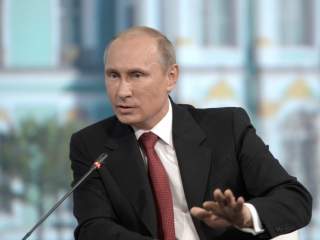Kremlin Caricature: Washington's Distorted View of Russia and Putin
Gleeful jokes come as more thoughtful consideration of the U.S.-Russia relationship is sorely needed.
What lies ahead? Democratic frontrunner Hillary Clinton likened Putin’s Crimea adventure to Hitler’s annexation of the Sudetenland—a morsel on the way to a full meal, in other words. On the Republican side, there seems to be a campaign competition for who can be toughest on Russia. Carly Fiorina has called for “regular, aggressive military exercises in the Baltic States” and vowed to not even talk to Putin. Ted Cruz has voiced support for expanding the U.S. law, the Magnitsky Act, that imposes visa and banking restrictions on Russian officials accused of human-rights abuses. Marco Rubio, who has branded Putin a “gangster,” has backed a proposed U.S.-policed “no-fly” zone in Syria even at an explicitly acknowledged risk of armed confrontation with Russia. With only 22 percent of Americans, according to the Pew Research Center, holding a favorable view of Russia, the hard line on Russia is the choice of least political resistance. No candidate from either party is bringing forth bold, fresh ideas for putting U.S.-Russian relations on a new footing—and that goes for President Obama, too. How about a bilateral summit between the leaders to see whether, as the Kremlin has hinted, it is ready to move beyond the Assad regime in Syria? Or directly involving Russia in a discussion at the United Nations Security Council to arrive at a plan of action against ISIS in the wake of the Paris attacks?
The lesson for the ages in how to deal with a difficult leader of the Kremlin was provided by President Franklin D. Roosevelt in his relationship with Josef Stalin. Roosevelt was well aware that the young Stalin, as a Bolshevik, was involved in robbery and even murder, and was well aware, too, of “indiscriminate killings” of innocent Soviet citizens under Stalin’s rule. “The Soviet Union,” he said in a speech in 1940, “is run by a dictatorship as absolute as any other dictatorship in the world.” Still, he did not permit himself to be diverted from the core U.S. objective of working with the Kremlin to defeat the Nazis. Toward this end, he did not even stoop at flattery: “The American people are thrilled by the magnificent fighting of your armed forces,” he wrote Stalin in April of 1942. To his personal physician, Roosevelt said of Stalin, “I bank on his realism.”
It is admittedly a gamble to depend on anyone’s realism, since leaders, and their countries, at times do behave irrationally. But there is nothing better to bank on. If a U.S. president can use his or her charm to get a bare-chested Putin to flatten ISIS, then three cheers. The task, as ever, is for clear-eyed understanding. Just as it was wrong to think in the 1990s that a feeble Russia, confronted by an expanded NATO, was apt to stay weak, so it is foolish to think now that a more confident Russia, bent on asserting its interests in Eastern Europe and the Middle East, is beyond the reaches of productive engagement. And those who point this out are no guiltier of appeasement than was the realist-minded Brent Scowcroft, denounced by neoconservatives for his prophetic warning, nearly one year after 9/11, of the folly of a war in Iraq. In order to see Russia clearly, America must see itself without illusions. It is when a great power fails to have a good understanding of its limitations that it can be most dangerous—to itself.
Paul Starobin, author of After America: Narratives for the Next Global Age, is writing a book on the city of Charleston, South Carolina, on the eve of the Civil War. He is a former Moscow bureau chief of Business Week.

